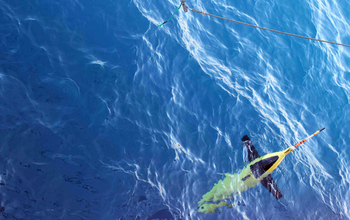Multimedia Gallery
Robotic gliders aid study of melting polar ice (Image 3)
A Seaglider released into the Weddell Sea off the coast of the Antarctic Peninsula in January 2012. The glider collected samples over a two-month period, measuring temperature, salinity and ocean currents to better understand how the ocean contributes to heat transport towards the Antarctic coastline. [Image 3 of 5 related images. See Image 4.]
More about this image
The rapidly melting ice sheets on the coast of West Antarctica are a potential major contributor to rising ocean levels worldwide. Although warm water near the coast is thought to be the main factor causing the ice to melt, the process by which this water ends up near the cold continent is not well understood.
In 2014, researchers from Caltech using robotic ocean gliders found that swirling ocean eddies, similar to atmospheric storms, play an important role in transporting these warm waters to the Antarctic coast -- a discovery that will help the scientific community determine how rapidly the ice is melting and, as a result, how quickly ocean levels will rise.
"When you have a melting slab of ice, it can either melt from above because the atmosphere is getting warmer or it can melt from below because the ocean is warm," said Andrew Thompson, an assistant professor of environmental science and engineering and the lead author of a paper published on the research. "All of our evidence points to ocean warming as the most important factor affecting these ice shelves, so we wanted to understand the physics of how the heat gets there."
The 6-foot-long gliders used for Thompson's research are energy efficient and can sample the ocean for much longer periods than large ships can. When a glider surfaces every few hours, it contacts the researchers using a mobile phone–like device located on the tail, allowing researchers to access data collected almost immediately.
The gliders were deployed off the coast of the Antarctic Peninsula in January 2012, where they spent the next two months moving up and down through the water column -- diving a kilometer below the surface of the water and back up again every few hours -- exploring the Weddell Sea off the coast of Antarctica. As the gliders traveled, they collected temperature and salinity data at different locations and depths of the sea. The results from the gliders revealed that the heat was actually coming from a less predictable source: eddies, swirling underwater storms that are caused by ocean currents.
"Ocean currents are variable, and so if you go just one time, what you measure might not be what the current looks like a day later. It's sort of like the weather -- you know it's going to be warm in the summer and cold in the winter, but on a day-to-day basis it could be cold in the summer just because a storm came in," said Thompson. "Eddies do the same thing in the ocean, so unless you understand how the temperature of currents is changing from day to day -- information we can actually collect with the gliders -- then you can't understand what the long-term heat transport is."
Thompson's glider work was supported in part by the National Science Foundation.
To learn more about this research, see the Caltech story Robotic Ocean Gliders Aid Study of Melting Polar Ice. (Date image taken: 2014; date originally posted to NSF Multimedia Gallery: Feb. 7, 2017)
Credit: Andrew Thompson/Caltech
See other images like this on your iPhone or iPad download NSF Science Zone on the Apple App Store.
Images and other media in the National Science Foundation Multimedia Gallery are available for use in print and electronic material by NSF employees, members of the media, university staff, teachers and the general public. All media in the gallery are intended for personal, educational and nonprofit/non-commercial use only.
Images credited to the National Science Foundation, a federal agency, are in the public domain. The images were created by employees of the United States Government as part of their official duties or prepared by contractors as "works for hire" for NSF. You may freely use NSF-credited images and, at your discretion, credit NSF with a "Courtesy: National Science Foundation" notation.
Additional information about general usage can be found in Conditions.
Also Available:
Download the high-resolution JPG version of the image. (1.2 MB)
Use your mouse to right-click (Mac users may need to Ctrl-click) the link above and choose the option that will save the file or target to your computer.



